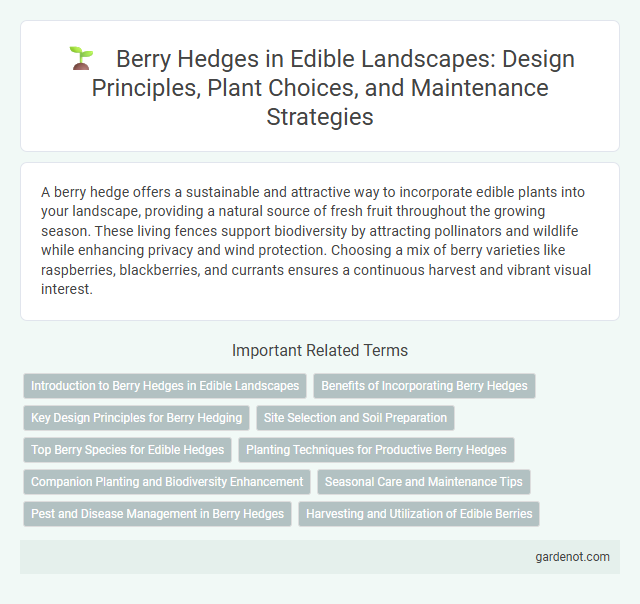A berry hedge offers a sustainable and attractive way to incorporate edible plants into your landscape, providing a natural source of fresh fruit throughout the growing season. These living fences support biodiversity by attracting pollinators and wildlife while enhancing privacy and wind protection. Choosing a mix of berry varieties like raspberries, blackberries, and currants ensures a continuous harvest and vibrant visual interest.
Introduction to Berry Hedges in Edible Landscapes
Berry hedges offer a productive and attractive element in edible landscapes, combining aesthetic appeal with tangible fruit yields. Common species include blackberry, raspberry, and blueberry, which provide seasonal harvests while enhancing biodiversity and soil health. Incorporating berry hedges supports sustainable gardening by attracting pollinators and serving as natural barriers or windbreaks.
Benefits of Incorporating Berry Hedges
Berry hedges provide a sustainable source of fresh fruits like raspberries, blackberries, and blueberries, enhancing food security in edible landscapes. They offer natural habitat for pollinators and beneficial insects, promoting biodiversity and healthier garden ecosystems. Incorporating berry hedges also serves as an attractive, space-efficient border that reduces soil erosion and requires minimal maintenance.
Key Design Principles for Berry Hedging
Berry hedges thrive when designed with plant spacing between 18 to 36 inches, ensuring optimal air circulation and sunlight exposure to reduce disease risk. Incorporating a mix of native berry species like raspberries, blackberries, and blueberries creates biodiversity that supports pollinators and enhances fruit yield. Soil preparation with well-draining, acidic conditions and regular mulching promotes healthy root development and consistent berry production.
Site Selection and Soil Preparation
Berry hedges thrive in well-drained soil with a pH between 5.5 and 7.0, making site selection critical to ensure optimal growth and fruit production. Choose a location that receives full sun for at least six hours daily and has good air circulation to prevent fungal diseases. Prepare the soil by incorporating organic matter such as compost to enhance fertility and structure, promoting healthy root development for berry plants.
Top Berry Species for Edible Hedges
Top berry species for edible hedges include native varieties such as blackberry (Rubus fruticosus), raspberry (Rubus idaeus), and gooseberry (Ribes uva-crispa), prized for their robust growth and high fruit yield. These species thrive in temperate climates, offering nutrient-rich berries packed with antioxidants and vitamins, making them optimal for garden biodiversity and sustainable food production. Incorporating these berry plants into edible landscapes enhances wildlife habitat while providing fresh, flavorful harvests throughout the growing season.
Planting Techniques for Productive Berry Hedges
Planting productive berry hedges involves selecting hardy, disease-resistant species like raspberries, blueberries, or blackberries suited to your climate zone. Establish rows with adequate spacing--typically 2 to 3 feet between plants and 6 to 8 feet between rows--to ensure sufficient air circulation and sunlight penetration. Incorporate well-draining soil enriched with organic matter, and apply mulch to retain moisture and suppress weeds, promoting vigorous growth and higher berry yields.
Companion Planting and Biodiversity Enhancement
Berry hedges serve as excellent companion plants by attracting pollinators and beneficial insects, which improve fruit yield and pest control. Incorporating diverse berry species like raspberries, blackberries, and currants fosters biodiversity, supporting various wildlife habitats. This practice enhances soil health through root symbiosis and contributes to a resilient edible landscape ecosystem.
Seasonal Care and Maintenance Tips
Berry hedges require regular pruning in late winter to remove dead or overcrowded branches, promoting healthy growth and better fruit production. Mulching annually with organic matter like compost or straw helps retain soil moisture and suppress weeds during the growing season. Consistent watering, especially in dry spells, ensures optimal berry development and prevents stress on plants.
Pest and Disease Management in Berry Hedges
Effective pest and disease management in berry hedges involves regular monitoring for common issues such as aphids, spider mites, and fungal infections like powdery mildew. Employing integrated pest management (IPM) strategies, including the use of beneficial insects, organic sprays, and proper pruning, helps maintain plant health and fruit quality. Choosing disease-resistant berry cultivars and ensuring adequate air circulation through strategic planting reduces the likelihood of outbreaks and supports sustainable edible landscapes.
Harvesting and Utilization of Edible Berries
Berry hedges yield abundant fruit typically harvested from late summer to early autumn, with peak ripeness indicated by deep color and plump texture. Harvested berries are ideal for fresh consumption, jams, jellies, and preserves, offering high levels of vitamins, antioxidants, and dietary fiber. Efficient utilization of edible berries includes freezing, drying, and fermenting to extend shelf life and enhance flavor diversity in various culinary applications.
Berry hedge Infographic

 gardenot.com
gardenot.com